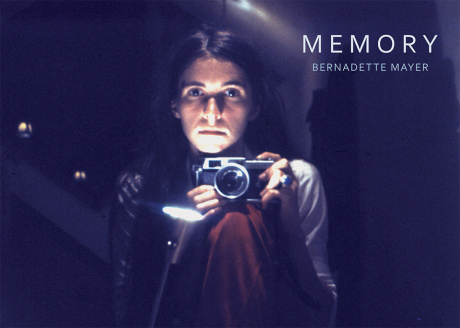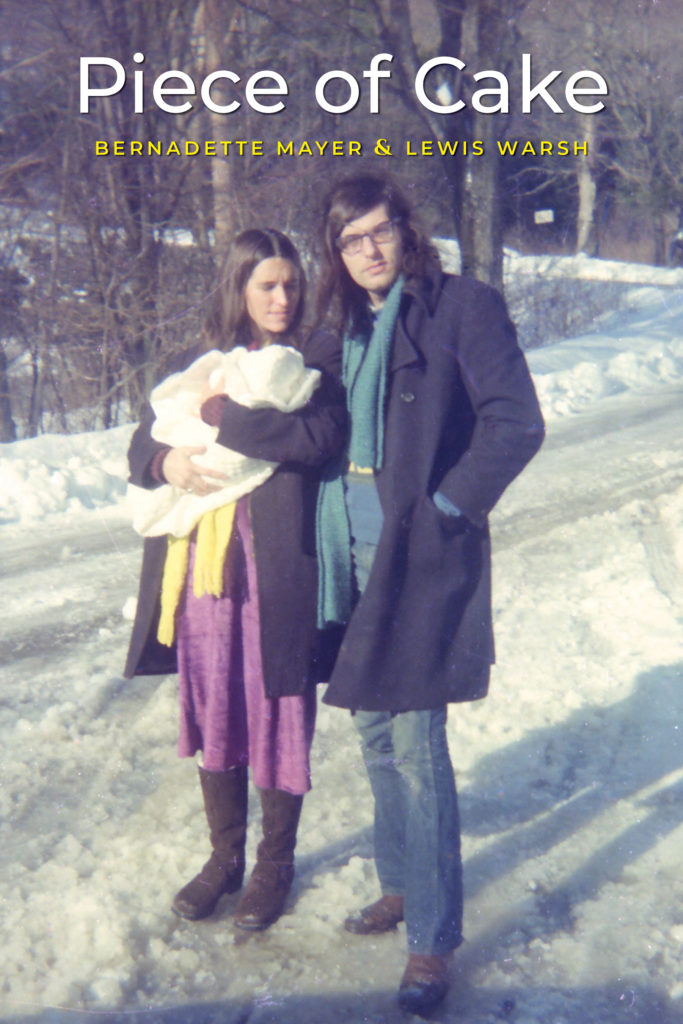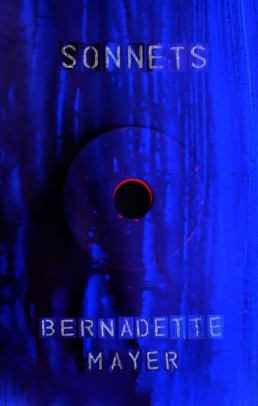Bernadette Mayer Time Machine: Anthony Madrid Reviews Memoryand Piece of Cake
The two main books discussed in this review:

Memory, by Bernadette Mayer. Siglio, 2020. 335 pages. ISBN: 978-1-938221-25-5 (hardcover). $45.

Piece of Cake, by Bernadette Mayer and Lewis Warsh. Station Hill Press, 2020. 323 pages. ISBN: 9781581771879 (paperback). $24.
*
When I was little, Bernadette Mayer’s books were hard to get. You couldn’t find anything. The Bernadette Mayer Reader (1992)—that’s it. And that was part of the romance. She had written all these books in degenerate, mimeographic 1970s New York City and then later in an irrelevant village in Massachusetts, and she had always been sublimely indifferent to fame and fuss. This is exactly what everyone in my milieu thought a genius was like: austere, self-propelled, humorlessly devoted to some homemade abstraction the rest of us couldn’t possibly understand.
Which is to say unreadable. For example, none of us had read Finnegans Wake, but we all trusted it was the greatest thing ever done. And just, well, really anything based on a perverse procedure was sure to rank high with us. How about a text where every single word is a mathematical pun? How about one where every letter of every word is printed in a slightly different shade of orange, and you have to refer to an index at the back to know what the shades mean? How about a film that runs for four months, and you’re not allowed to sit facing it. And so on. For at least a decade of every young artist’s life.
This is how Mayer started out. All her first books are “beyond the beyond.” They can be read, but they cannot be read. Take Memory (1971). Here’s the recipe: shoot a roll of film every day, for a month. Meanwhile, keep a journal. Later, improvise an interminable text based on the journal + whatever the photos remind you of. Not what they remind you of in general—what they remind you of, from the day the pictures were taken. The typing-up process is obviously tedious, so save time by typing it any old way. Punctuation when you feel like it, etc. After all, you’re not really trying to secure discrete effects. Just fill the typing paper.
The text of Memory is as uninteresting as I’m making it sound. Whatever interest accrues happens quite accidentally. For instance, one perceives that Mayer made a visit to the World Trade Center when it was being built. There are a few photos of it, with tarps still on some of the windows. One thinks of 9/11 of course, and consequently one studies the pictures with some care. They don’t tell you much, though. And Mayer’s text tells you next to nothing:
There wasnt much recording to do this day though because everything was closed or empty. Ed was still asleep when I got up. I washed at least 3 blue shirts to take to massachusetts & overexposed them on the fire escape. Tom said the overexposed ones look like a casket. Then I washed our blue hockey shirt, my 30s outfit, a lot of t-shirts including anne’s tie-dyed one, two pairs of army green socks, ed’s pants & hannah’s green & white shirt. Put them out to dry. It was sunny. We went out, I had wanted to go down to the world trade center so we did. Couldnt get close enough to it so we drove down broadway to barclay street & when we left up deserted washington street, not exactly deserted but torn down, the whole north-south side of it, just lots & the most interesting thing about the wtc was the rust on all the materials.
It’s not quite true that any snippet of Memory is like any other. Sometimes the stuff is straight-up zibzib. Like, look at the very beginning of the same entry (4 July 1971):
Twelve seventeen & ten seconds bright day warms up, I warm up, I have little mats stapled into my nails, owning elephants, this space for a field, remember? Ed wet went “to get some cars,” cigarettes and money flew, HC-110 at 7:1 dilute B at 68º straight-hypo, into cans, stop bath in beaker, take temp of HC-110, 68º, get time, lights off, roll & cover on, shake 30 seconds…
At any rate, one has to take a second to consider what’s not here. For starters, reflection. There is no drive towards insight. Then, too, there are no feelings either. All of Memory, and indeed all of Bernadette Mayer 1.0 is written in emphatically flat affect. Pretty sure this doesn’t change ’til the ’80s.
Meanwhile, just out from Siglio is the best version of Memory ever made public. I don’t mean the best book version. It’s the best version, period—very much including the original installation, and the two that were put up more-or-less recently. I was three when the original deal was displayed, and I’ve never been to Canada, but I did see the installation at the Poetry Foundation, in Chicago. And I repeat: this book is the best version ever done.
Why. Because if you put 1200 photographs on a wall in this configuration:

…the viewer can’t really look at ’em. Or, all right, anything’s possible, but c’mon. IRL, one looks over the whole spread, then glances at a few random pix, and gives up. Likewise, I wonder if any living soul, including Mayer herself, has ever listened to the entire six-hour tape of her reading the Memory text aloud. It played, exactly once, at the original gallery showing; nowadays it can be listened to here.
A few words of warning to the intrepid who are about to click on that link. One, there’s a lot of white space at the beginning. Two, the sound level was much too low at first, then they fix it. Three, if you have the Siglio Memory open in front of you, you will think there’s been some mistake; it takes three and a half minutes for her to get to the part that’s on page 1 (as it were) of the book text. And lastly, the thing she’s reading is actually rather longer than what you’ve got on the page. The book text is a pared-down version. (One thing you’ll notice right away: the tape version makes more sense, because mostly when she pares down the text for her book, she’s scraping away connectives and antecedents necessary to sense making.)
To return to the pictures, they’re pleasant, a lot of ’em, and it’s nice to be able to look ’em over properly. I suggest studying the photos associated with any given day very closely before reading the text, because a certain amount of the text is unintelligible without reference to the photos. Lots of times, she’s talking explicitly about them.
Memory helps you see her philosophy, too. Here’s BM in 2019:
It’s astonishing to me that there is so much in Memory, yet so much is left out: emotions, thoughts, sex, the relationship between poetry and light, storytelling, walking, and voyaging to name a few. I thought by using both sound and image, I could include everything, but so far, that is not so. Then and now, I thought that if there were a computer or device that could record everything you think or see, even for a single day, that would make an interesting piece of language/information….
Now, if this sounds like the Kenneth Goldsmith of Fidget and Soliloquy to you—yeah. But there’s a difference. Goldsmith is a self-appointed trickster god—his motivation is fundamentally play. That fact is key to the much deeper perversity of Mayer. She ain’t playing, so the whole pay-schedule of dangers and treasures is different. Mayer risks ice-cold emptiness; Goldsmith risks annoying the living fuck out of people. Indeed, they both run right off their chosen cliffs—but not always, not always.
Skip forward five years from Memory—to 1976. The state of the world has changed a lot. While Mayer was shooting those rolls of film in 1971, Jimmy Page was in LA, mixing Zeppelin IV. Yet, by the late summer of 1976, Jimmy Carter is about to be elected, Mayer is married, has a kid, is living on food stamps in Lenox, Massachusetts. This is the backstory of Piece of Cake, out now for the first time from Station Hill.
There must be a handful of people out there who have been waiting for Piece of Cake for a long time. Apparently, it languished in a drawer for forty-five years. I’m quite, quite curious about what’s up with that. Anyone with anything other than a passing interest in the case will want to look at this thing.
Specs. Every day, for the month of August 1976, BM and her then-husband Lewis Warsh worked on a documentary book together. They alternated days, so you get fifteen days of Mayer and sixteen of Warsh.
It is diary-like, but they were smarter than that. They do not confine themselves to the events of the day, and—this is important—they do not participate in I-do-this-I-do-that-ism. Their motto is NOT “Let it speak for itself.” Instead, they have thoughts and evaluations.
Nothing, or next to nothing, happens in the course of the month. Lewis’s parents visit for a week. Bernadette goes to the doctor. Lewis’s old students from NYC visit for a night. They play some bridge. There are lots of trips to the library, walks around the park. As Dr. Johnson said of a very different book: We must read it for the sentiment. Whoever reads it for the plot will fret herself to death.
I, anyway, read it with continuous interest, because I wanted to get a better handle on Mayer’s personality. My questions were:
-
Does she exhibit the ordinary complement of human vanity regarding her work, her seriousness, her Bohemianism, and so on—?
-
Is she really as humorless in this first phase as she seems (judging from Memoryand the relevant material in the Bernadette Mayer Reader)—?
ANSWERS
(a) Not vain at all, as far as I can see. (b) Utterly humorless.
I hasten to say: When someone is described as “humorless” that doesn’t mean they never laugh, never say anything funny, and have no fun. It means they’re never silly, and seldom playful. When something zany happens, they never started it. They might participate; they might even laugh and laugh hard. But they rarely cause others to laugh hard, at least not intentionally. In this sense, babies and animals are humorless.
When humorlessness in adults reaches a certain extreme, one begins to use words like morbid. In my opinion, Memory is morbid. Piece of Cake is largely morbid. Midwinter Day is morbid. But!! At some point in the 1980s something happened. Mayer’s The Sonnets were not written by the same mentality that wrote any of the books before it. There is wild humor, there is egotism, there are demands. A lot of it doesn’t make any damn sense, but it’s a different kind of not making sense. It’s more like, I wanna say, John Berryman. In other words it’s more beguiling.
There is always a very small handful of poets, at any given moment, who can do this sort of thing. Mayer, in that moment, was one. And if you take a minute to think about what kind of dreary stuff was going down in the mid-’80s in American poetry, you can catch a glimpse of how exhilarating Sonnets must have been, when the book dropped. For the two or three people who could get ahold of a copy.
Just a few years back, the visionaries at Tender Buttons Press did up a splendid version of The Sonnets, this:

Now, that’s the kind of thing that can only be produced when the publishers have a real love investment. It wasn’t just the text of the Sonnets; it had a couple appendixes full of outtakes and additional Mayer sonnets produced since 1985. People really like watching her develop!
Which brings us back to the cases at hand. Memory—you’re never gonna read it raw. But you might read it in tandem with that tape. And also? even if you’ve seen the photos, you haven’t seen the photos; you need ’em on a table or in your lap. The only remedy is this Siglio version. And you know what, $45 is not that bad for what you’re getting. It’s an art book. Every page is made out of plastic.
As for Piece of Cake, it’s full of typos, the photo on the front is annoying…and it’s utterly essential to getting a handle on where she was at. As a text, it’s worth a hundred Memorys. Her and Warsh both come off absurdly self-serious, earnest, honest. They talk about things in their pasts with a minimum of bullshit. They have plenty to say.
You wind up doing the math, and it comes out Mayer was thirty-one, and you think: “If I had tried this same experiment when I was thirty-one, the results would have been fatal.” And you’re right. Because you would have striven to be (a) entertaining, and (b) deep. In other words, you would have never lost sight of the desire to make yourself look good. Whereas, Mayer and Warsh were more like Samuel Pepys. “Just get the stuff down, whole. Don’t worry ’bout what it means.” I found myself helplessly admiring their integrity.
Note that both of these just-published items are “staged” to deliver one month of life each: July 1971, August 1976. It’s very pleasing they both came out simultaneously like this. They’re fun to compare.